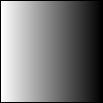

An Introduction to DBN by John Maeda
DBN is a simple language designed to introduce the most basic ideas of computer programming in the context of drawing. Each command in the DBN language is qualified with some number that is generally between the range of 0 to 100.
In the case of the first command 'Paper', by running the program 'Paper 50' you get a 50% black paper (gray); 'Paper 100' will be 100% black (complete black).
The second command to learn is 'Pen', again using a number to specify the percentage of black, 'Pen 50' implies a gray pen, 'Pen 0' implies a white pen.
The third command to learn is 'Line'. A line is specified by four numbers. The first two numbers are the horizontal and vertical dimension of the first point; the second two numbers are likewise the horizontal and vertical dimension of the second point. A line from the lower left corner (0 0) to upper right corner (100 100) would be 'Line 0 0 100 100'.
To review, the following 3 line program draws a black line on a white paper:

|
Paper
0 Pen 100 Line 0 0 100 100 |
Drawing more lines implies simply using the Line command more often, such as in a square:

|
Paper
0 Pen 100 Line 10 10 10 90 Line 10 90 90 90 Line 90 90 90 10 Line 90 10 10 10 |
There are more complex expressions possible, which I describe in better detail in the book 'Design By Numbers' from MIT Press. For now, try out:

|
Paper
0 Pen 100 Repeat A 0 100 { Pen A Line A 0 A 100 } |
Design By Numbers
is Copyright 1999-2001, Massachusetts Institute of Technology.
DBN
was developed by the Aesthetics and
Computation Group at the MIT Media Laboratory.